
Addressing Temporary Construction Heat
October 28, 2020 | By Ian McTeer
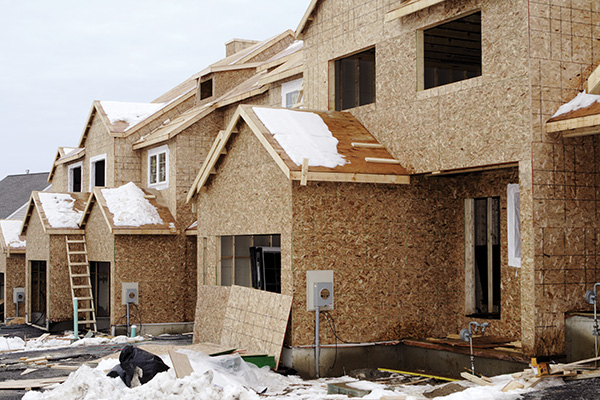
(Getty Images)
The headline of an online article dated July 18, 2019 immediately captured my attention: “Why your new home may come with a dirty, used furnace” by Laura Osman of CBC news, Ottawa. Accompanying the article were several photographs of an unhappy homeowner in Morrisburg, Ont. pointing to his furnace and saying, “I opened up the front of the furnace and it just looked like a bag of flour exploded in there.”
Osman continues to explain that the practice of using furnaces meant for comfort conditioning is legal during the construction process, and that some manufacturers say they are not receiving complaints therefore all must be well. Warranty records documenting premature failures would tell a different story; however, that vault of closely held manufacturer information will not be made public anytime soon.
Some History
I remember the days when large-scale house construction went into winter hibernation. Many in the HVAC trades were laid off in December and spent the winter doing whatever else they could—I delivered furniture at one time.
Builders deserve a great deal of credit for harnessing technologies that allowed house construction to continue through the winter providing year-round employment for those of us in the residential heating industry. Superplasticizers and self-consolidating concrete combined with other warming techniques meant basements could be poured into the winter months. Builders take precautions to prevent fresh pours from freezing so that compressive strength is not compromised.
Once the concrete pour had set-up enough, carpenters started framing. Typically, propane-fired salamanders were employed to keep the foundation warm during the framing process. Installation of the roof sheathing meant the sheet metal rough-in including a B-vent chimney could start, followed closely thereafter by the basement duct and furnace.
Then the rush was on, get the furnace gas-piped and wired so that it could be used to keep the structure warm, even if all the windows and doors had yet to be installed. Sometimes the basement floor, yet to be poured, required the furnace to be suspended 4-in. above the gravel using plumber’s metal strapping allowing the concreting job to be done later.
And, sometimes, the furnace was fired-up without ducting, the blower door was removed allowing heated air to simply flow out the top, that was before door interlock switches became a requirement.
The old draft hood equipped furnaces of yesteryear with their cold rolled steel heat exchangers, pilot lights, ribbon burners and belt-driven fans seemed almost indestructible back then. Starting one of the old blisters in a basement at 20F required some finesse, as the chimney would be so cold the flue products would start spilling into the basement until the B-vent warmed up. Condensation would also occur inside the heat exchanger; you could hear the water boiling in there. The bimetal fan control took ages to warm up enough to start the fan, then the return air was so cold the fan would cycle off seconds later. Salamanders, when used, put some heat into the building making the furnace start-up less traumatic.
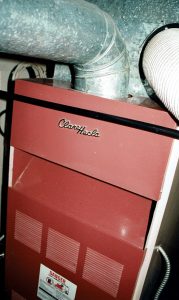
Clare Hecla furnace.
Some great Canadian-made furnaces such as the Clare Hecla (later Clare Brothers or simply Clare) model pictured to the left (not to mention, marques like McClary, Anthes, Grimbsy, Smart’s, Olsen, Conroy, Findlay, Goodcheer and others) all had their day in houses under construction at one time or another.
After surviving seemingly relentless clouds of drywall dust whilst heating the house under construction, unevenly loaded blower wheels would start shaking the furnace like an unbalanced washing machine causing consumer complaints.
Only one way to fix this problem: remove the blower, disassemble and clean the blower wheel with water, as no amount of brushing could remove drywall dust once centrifugally packed onto the blades.
Today’s furnaces use direct drive centrifugal blowers, the motor is secured into the assembly using a belly band or resilient mount, both styles then bolted to the blower housing. An out-of-balance wheel will stress the mounts to the point of failure or even cause the blower wheel to collapse.
I accept the argument such failures can happen at any time during the life of a furnace or air handling unit mostly caused by lack of proper maintenance. Yet, it is still the end user’s right to start off with a clean machine to abuse, or not, down the road.
Service Calls
An air handling unit (AHU), such as a gas furnace, cannot function properly or deliver its advertised benefits with a filthy or damaged blower wheel. Arguably, it is one of the most important AHU maintenance items, yet the entire blower assembly is too often exceptionally difficult to access for cleaning.
Since no one has ever developed a tool meant for cleaning centrifugal wheels in place, it is still necessary to pull the blower for disassembly and cleaning. Modern gas furnaces have slide-out blowers, decidedly an improvement over the securely bolted blowers of yesterday, however, now the service tech is faced with disconnecting things like the control board platform, condensate tubing and thermostat wiring.
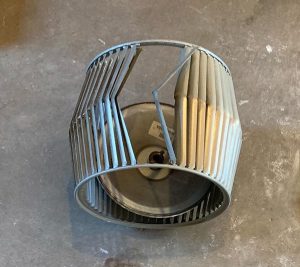
Collapsed blower wheel.
Other components, not necessarily affected by dust and dirt, nevertheless suffer from the rigors of construction heat. A heavily loaded blower wheel may cause the unit to overheat thus continually cycling the limit control causing it to fail-open thereby generating a no heat service call.
Limits are safeties (not operating controls) and typically do not reset after cycling repeatedly. Gas valves and hot surface igniters will have some advertised reliability vanish, stolen by useless cycling in a dusty, damp basement. Apart from blower wheels, the most common premature failures related to temporary construction heat are blower motors, draft inducers, burners, and flame rods.
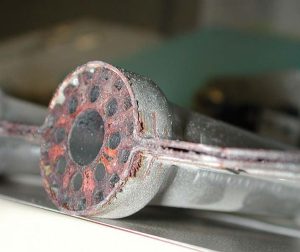
Gas burners and flame rods readily corrode in the face of contaminated combustion air.
Low temperature rise creates unacceptable amounts of condensate especially in the primary heat exchanger. Furnace manufacturers want a minimum return air temperature maintained, typically 55F or 13C. New construction invariably records return temperatures considerably lower promoting excess condensation in all the wrong places.
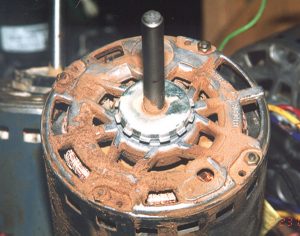
PSC fan motors fail electrically, or seize mechanically, within the first year of operation.
Ultimately, acidic condensate becomes further contaminated with chlorides and fluorides contained in paint, varnishes, cleaning compounds, stains and curing concrete potentially leading to rapid deterioration of the heat exchangers. Aluminized steel, thus exposed to corrosive elements, cannot be expected to stand the test of time.
Industry Reaction
It’s not as if consumer complaints fall on deaf ears. Industry regulators and manufacturers have developed a standard for temporary heating that is typically included in the “Safety Section” of gas furnace installation instructions. As part of the ANSI Z21.47/CSA 2.3 standard, temporary heating is allowed if:
- Furnace and vent system are complete and installed per manufacturers instruction
- Furnace is controlled by a room temperature thermostat
- Furnace return air duct must be complete and sealed to the furnace
- Furnace input rate and temperature rise must be verified as per the rating plate
- Furnace combustion air must come 100% from outdoors
- Furnace return air temperature range is between 55°F (12.7°C) and 80°F (26.6°C)
- Furnace must be supplied with an external, field supplied air filter.
- Furnace, duct work, and components must be cleaned upon substantial completion of the construction process.
- Furnace operation must be in accordance with manufacturer’s instructions.
While having a well-articulated standard providing rules for temporary heating helps both builders and HVAC contractors to provide excellent products to the public, unfortunately not all appear to be using the guidelines properly as noted in the recent CBC article.
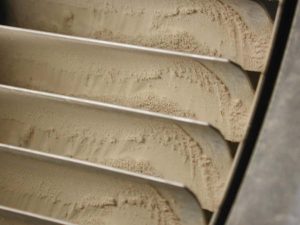
Accumulation of dirty drywall dust.
Obviously, the new homeowner’s furnace had been used for temporary heat but had not been cleaned properly, if at all. Drywall dust is so insidious, cleaning a fin-tube secondary heat exchanger while lying on ones back inside the empty blower compartment is something I doubt gets done very often after construction ends.
When drywall sanding hits high gear, cleaning/changing the furnace air filter would be a daily requirement, yet, conventional 1-in. air filters are useless against drywall dust. A MERV 11 filter would load up quickly eventually blocking airflow. Furnace air filters were never meant for construction applications. Efficient filtration would require frequent intervention by some person to change loaded filters thus maintaining airflow.
Having worked in basements with a roaring propane salamander sounding a like jet airplane on afterburner, I can understand why the trades hate them. Somehow, the temperature of the building must be raised by other means before the furnace is started to prevent premature failures.
It really means that a furnace meant for human comfort conditioning should not be started until the construction phase is substantially completed, a point in the process often called “carpet phase.”
By then, drywalling should be completed and with construction dirt and debris cleaned out of the ductwork, the furnace is ready to start its life.
Legislation?
I am a classic liberal at heart, I do not believe the heavy hand of governments must regulate every function of our lives. Best practices need not carry prescriptive regulation if the group is willing to acknowledge certain instructions must be followed beforehand. Yet, best practices have been ignored too often when it comes to protecting a new homeowner’s investment.
Damaged parts, such as those I have included in this article, required a service call—a new homeowner had no heat. The homeowner had to wait at home for the service technician, possibly missing work, a major inconvenience.
Poor performance caused by filthy heat exchangers or blower components also require a service call, sometimes by an inexperienced technician and, frustratingly enough, the issue is not always resolved to the homeowner’s satisfaction leading to more service calls.
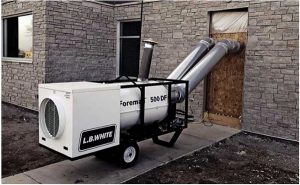
Here is a much better way to provide temporary construction heat, a portable heater.
Since a high-efficiency furnace is meant to save energy, how much does the collective energy budget of a given house balloon when an abused furnace component fails? Another motor must be manufactured, delivered to a store, carried to a job-site in a vehicle, all this extra inefficiency must be added onto that house. Energy is energy, does it matter if the furnace is using it or the service truck burning through a tank of gasoline while the furnace is down?
One comment to the CBC article noted, “crying over nothing, a couple of weeks max out of 15 years. You ain’t gonna notice.” Well, dear reader, you can tell that to any of the homeowners unduly affected by no heat or poor performance from brand-new heating systems.
The article also noted that the Canadian Standards Association (CSA) has been in talks with industry groups with the goal of developing better standards and common guidelines, but nothing is expected from these discussions until 2021.
Our industry does not need any more media reports about unhappy customers. In the meantime, I would simply suggest that the best practice to prevent damage and premature failures of brand-new heating equipment is this: Don’t use it for temporary heat. <>

 Ian McTeer is an HVAC consultant with 35 years experience in the industry. He was most recently a field rep for Trane Canada DSO. McTeer is a refrigeration mechanic and Class 1 Gas technician. He can be reached at imcteer@outlook.com.
Ian McTeer is an HVAC consultant with 35 years experience in the industry. He was most recently a field rep for Trane Canada DSO. McTeer is a refrigeration mechanic and Class 1 Gas technician. He can be reached at imcteer@outlook.com.


